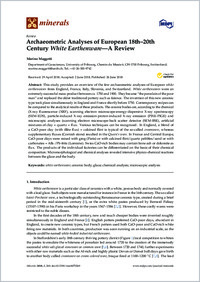Archaeometric analyses of european 18th–20th century white earthenware—a review
DOKPE
- Maggetti, Marino Department of Geosciences, University of Fribourg, Switzerland
-
26.06.2018
Published in:
- Minerals. - 2018, vol. 8, no. 7, p. 269
English
This study provides an overview of the few archaeometric analyses of European white earthenwares from England, France, Italy, Slovenia, and Switzerland. White earthenwares were an extremely successful mass-product between ca. 1750 and 1900. They became “the porcelain of the poor man” and replaced the older traditional pottery such as faïence. The invention of this new ceramic type took place simultaneously in England and France shortly before 1750. Contemporary recipes can be compared to the analytical results of these products. The ceramic bodies are, according to the chemical (X-ray fluorescence (XRF), scanning electron microscope- energy-dispersive X-ray spectroscopy (SEM-EDS), particle-induced X-ray emission- proton-induced X-ray emission (PIXE-PIGE) and microscopic analyses (scanning electron microscope-back scatter detector (SEM-BSE), artificial mixtures of clay + quartz + flux. Various techniques can be recognized. In England, a blend of a CaO- poor clay (with illite flux) + calcined flint is typical of the so-called creamware, whereas supplementary fluxes (Cornish stone) resulted in the Queen’s ware. In France and Central Europe, CaO-poor clays were mixed with grog (Paris) or with calcined flint/quartz pebbles/sand or with carbonates + Alk-/Pb-frits (Lorraine). Swiss CaO-rich bodies may contain bone ash or dolomite as flux. The products of the individual factories can be differentiated on the basis of their chemical composition. Micromorphological and chemical analyses revealed intensive physico-chemical reactions between the glaze and the body.
- Faculty
- Faculté des sciences et de médecine
- Department
- Département de Géosciences
- Language
-
- English
- Classification
- Archeology
- License
-
License undefined
- Identifiers
-
- RERO DOC 323370
- DOI 10.3390/min8070269
- Persistent URL
- https://folia.unifr.ch/unifr/documents/307428
Statistics
Document views: 157
File downloads:
- pdf: 304
